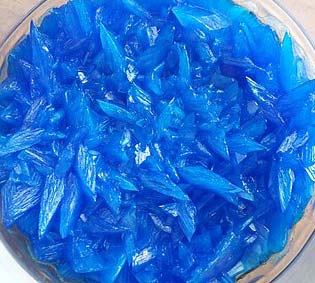|
1. Rain water is weakly acidic because it contains dissolved carbon dioxide. Which of these is a possible pH for rain water? |
|
| 2. Litmus, phenolphthalein and methyl orange are all indicators which can be used to distinguish between acids and alkalis.
What are the correct colours of these indicators in alkali?
| |
litmus |
phenolphthalein |
Methyl orange |
| A |
blue |
colourless |
yellow |
| B |
blue |
pink |
yellow |
| C |
blue |
pink |
red |
| D |
red |
colourless |
red |
|
|
| 3. Four solutions with different pH values were tested with universal indicator.
Which row shows the colour of each solution after the indicator was added?
| |
pH 9 |
pH 1 |
pH7 |
pH6 |
| A |
purple |
red |
yellow |
orange |
| B |
red |
yellow |
green |
blue |
| C |
blue |
red |
green |
yellow |
| D |
blue |
green |
yellow |
orange |
|
|
| 4. Slaked lime (calcium hydroxide) is used to neutralize acidic soils. |

Peter Turner | CC-BY-SA 2.0
|
Which ion is responsible for neutralizing the acid in the soil?
- A. Ca2+
- B. H+
- C. OH-
- D. O2-
|
|
5. Which is NOT a typical characteristic of acids?
- A. They react with metal oxides producing hydrogen
- B. They react with carbonates producing carbon dioxide
- C. They react with alkalis producing water
- D. They turn blue litmus paper red
|
|
6. Acids form salts. Select the row that correctly states the type of salt formed from each acid.
| |
Hydrochloric acid |
Sulfuric acid |
Nitric acid |
| A |
chlorate |
sulfide |
nitride |
| B |
chlorate |
sulfate |
nitrate |
| C |
chloride |
sulfate |
nitride |
| D |
chloride |
sulfate |
nitrate |
|
|
Q7-9:
A student prepared a sample of hydrated copper(II)sulfate crystals by reacting excess copper(II)carbonate with dilute sulfuric acid. |

Crystal Titan | CC 4.0
|
7. The equation for this reaction with the correct state symbols is ..
- A. CuCO3(s) + H2SO4(l) → CuSO4(l) + H2O(l) + CO2(g)
- B. CuCO3(s) + H2SO4(aq) → CuSO4(aq) + H2O(l) + CO2(g)
- C. CuCO3(s) + H2SO4(l) → CuSO4(aq) + H2O(l) + CO2(g)
- D. CuCO3(aq) + H2SO4(aq) → CuSO4(aq) + H2O(l) + CO2(g)
|
|
8. How would the student know when she had added an excess of copper(II)carbonate?
- A. the solution would turn blue in colour
- B. the temperature would rise
- C. effervescence would stop and solid would remain in the mixture
- D. all the solid would disappear
|
|
9. What techniques would the student use to:
(a) separate the excess copper(II)carbonate from the mixture?
(b) obtain hydrated copper(II)sulfate crystals from the solution? |
|
| |
Separate excess copper(II) carbonate |
Obtain hydrated copper(II)sulfate crystals |
| A |
filtration |
crystallisation |
| B |
evaporation |
distillation |
| C |
filtration |
distillation |
| D |
evaporation |
crystallisation |
|
|
10. Which statement is NOT true about bases?
- A. Bases are proton acceptors
- B. An alkali is an insoluble base
- C. Copper(II)hydroxide and ammonia are bases
- D. Bases can neutralize acids
|
|
|